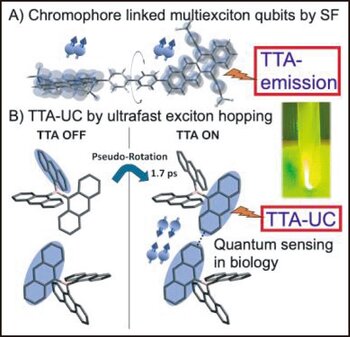[Division Topics] Spin quantum effect on light-energy conversion by vibronic motion of exciton
Chemistry and Chemical Industry, Vol.78 No.9 (2025)
Light-induced quantum coherence exhibiting harmonic quantum inteferance has been found in various condensed matter systems, including biological phenomena, and there are great expectations for its development in molecular spintronics triggered by the 'second quantum revolution'. In singlet fission (SF)1,2), by which two triplet excitons are generated by one-photon excitation, and in triplet-triplet annihilation upconversion (TTA-UC)3), which produces a singlet exciton emitting short-wavelength photon via encounter of the two triplet excitons, the spin-multiplicity change of the exciton pairs in the intermediate state is the key to high efficiency. By using the steric effects and anisotropic molecular vibrations of molecular assembly structures and linked molecular chromophores in condensed matter systems, it has become possible to manipulate qubits such as quintet, quartet and quantum superposition state to cause energy conversion (Figure) 1-4).
Given these advances in quantum technology, the development of optical energy conversion devices that utilizes molecular vibrations is expected to advance in the future, and to be applied to a wide range of fields, such as photodynamic cancer treatment using near-infrared light, which does not harm the human body, and to sensing the microfluidic environment inside cells.
1) S. Matsuda, et al., Chem. Sci. 2020, 11, 2934.
2) T. Hasobe, et al., ACS Energy Lett. 2022, 7, 390
3) K. Higashi, et al., Angew. Chem. Int. Ed. 2025, DOI: 10.1002/anie.202503846.
4) Y. Kobori, et al., J. Chem. Phys. 2025, 162, 054505.
Yasuhiro Kobori, Molecular Photoscience Research Center, Kobe University

